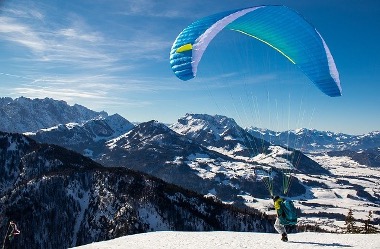In the US, paragliding has been steadily growing in popularity over the last decade. According to the US Hang Gliding and Paragliding Association (USHPA), membership has spiked ‘as a result of the increasing participation in paragliding.’
Jerome Clavel is an avid paraglider and explains below how aspiring novices can get started in the sport.
Paragliding Membership on the Rise
The sport, which can be traced back to the 1950s, to French inventor Pierre Lemoigne, involves flying parachutes modified to enhance gliding. Jerome Clavel notes that paragliders do not use a rigid framework and instead rely on the fabric of the parachute canopy, specially modified to inflate as air passes through the wings.
Since Lemoigne’s invention, the hobby has developed into a sport that attracts thousands of participants each year. The USHPA reports that membership is on the rise, making it critical for participants to approach the sport from an informed standpoint.
How to Get Started
According to Jerome Clavel, there are five main steps to getting started in paragliding:
1. Choose an Instructor
Paragliding is not a sport that can be self-taught; new paragliders must find a school and work with an instructor. Resources such as the USHPA website can help new users find nearby training facilities.
Instructors can have a range of qualifications, including USHPA certification, Professional Air Sports Association (PASA) certification, or non-PASA certification.
2. Take Lessons
Jerome Clavel says new pilots must become comfortable with the glider’s motions before flying, so initial lessons are spent on the ground learning about equipment.
New pilots learn theory, witness flights, and learn about wind conditions and landing spots. The rigorous training program entails specific studies mandatory for gaining each level rating.
3. Spend Time With Pilots
New students should also spend time with other pilots to exchange information, build relationships and become involved in the growing paragliding community. Flying with other pilots also means that help is on hand to launch and tow.
4. Buy the Right Gear
Because of the growing number of people enjoying paragliding, the global paragliding equipment market size is also increasing. It was estimated to be worth $321.79 million in 2021 and projected to be worth $349.27 million in 2022 and $536.07 million by 2026.
Much of the cost comes from buying proper equipment. It is essential in paragliding to have gear tailored to each pilot, and the instructor or training school is going to be the best source for deciding what to get.
5. Learn About Weather
The wind is a paraglider’s best friend and worst enemy: without the wind, paragliders cannot fly, but if the wind suddenly changes direction or speed, it can cause severe, and even fatal, problems. Jerome Clavel says because of this, new pilots must learn about aviation meteorology.
According to the United States Environmental Protection Agency (EPA), storm intensity, duration, and frequency have increased over 20 years, making mastering meteorology ever more crucial.
Extra: 6. Find a Chapter
An extra tip for new pilots is joining a ‘chapter,’ a member-controlled group of certified paragliders.
What Equipment Is Needed?
The necessary equipment—sturdy hiking boots, a helmet, harness, parachute, glider, and radio—will likely set new pilots back a hefty sum. Buying new equipment through instructors is always advised as they work directly with trusted companies, and, as mentioned above, will steer you toward exactly what you need.
Faulty or sub-par equipment sold as new flood online markets. Buyers need to be careful as online fraud attempts in the US have increased by 25% on last year’s figure. Instructor consultation is advisable to avoid running into difficulties.
What to Expect on the First Lesson
Jerome Clavel says initial lessons focus on handling the glider, learning vocabulary, and studying up on meteorology. ‘Kiting’—the art of learning to handle the glider—is the foundation of being a safe and successful pilot.
It usually takes at least ten days of flyable weather before novice pilots reach the minimum standard required to fly unsupervised.
Key Places to Go
After new paraglider pilots gain confidence and experience, they can use hundreds of spots across the country. Often, national parks will have designated paragliding points that pilots can use following registration.
Safety
There are obvious risks that come with paragliding. Jerome Clavel notes that paragliders can fly as high as 15,000 feet and for as long as three hours, meaning that falls can be fatal. In 2019, there were 9 USHPA recorded deaths in the US.
The way to manage these risks is by studying thoroughly, checking over equipment before flights, and always following the safety procedures shared by instructors.
Looking to the Future
As paragliders gain experience, they can enjoy becoming part of a tight-knit worldwide community. Paragliding activities and competitions happen around the world and have since 1989, when the first-ever Paragliding World Championship took place in Kossen, Austria.
Conclusions
Jerome Clavel says those looking to get started in paragliding will be pleased to know that they are part of a growing community. With clear instructions on how to learn and improve, and with certified bodies running schools and chapters across the country, new pilots will be able to get involved in the sport safely and with ease.









